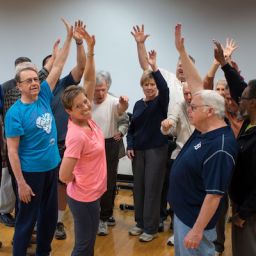In 2006, physical therapists Lee Dibble, Terry Ellis, and Gammon Earhart received funding from the Davis Phinney Foundation for the CHOP PD study, in which they hoped to lay a foundation for subsequent exercise trials that would show how exercise and physical activity can improve quality of life (in addition to many other benefits) for people with Parkinson’s. They recently joined us to talk about their research and how physical therapy can play a significant role in helping people live well with Parkinson’s.
“Following the CHOP PD study, many more exercise trials have been done showing the true benefits of exercise in mitigating symptoms and improving function in people with Parkinson’s disease. So I think it was some of the early work that provided the groundwork for subsequent studies that have been done.”
-Terry Ellis, PT, PhD, NCS
To access the recording of the webinar, click here.
To download the audio, click here.
To download the transcript, click here.
Show Notes
-
Visiting a physical therapist (PT) soon after a Parkinson’s diagnosis is important because you can not only start building a relationship with this member of your care team, but you can get an assessment from them that will help you plan your next steps and determine which physical therapy approaches are optimal for you.
-
PTs can spend time assessing your current levels of walking, balance, and more, and then personalize an exercise plan for your unique needs and wants.
-
Using a secondary prevention (or what the three panelists call the “dental”) model can help you plan your PT visits. Terry explains that visiting a PT can and should be like visiting a dentist; you go every six months or every year, whether or not you think something is wrong.
-
PTs often work closely with other allied health professionals, including occupational and speech-language therapists. This, Lee says, can help people with Parkinson’s optimize their care.
-
Although all PTs receive some training in Parkinson’s, those who specialize in neurological physical therapy have a much deeper understanding of Parkinson’s. “They have additional training and are more well-versed in the literature,” Terry says.
-
The “best” type of exercise is different for everyone. While some people benefit most from high-intensity training, others need to focus more heavily on balance and flexibility. PTs can assess your mobility and make a personalized plan that suits you. Individualized care is one of the primary reasons working with a PT is so beneficial.
-
A new study (SPARX3) the panelists are involved in will investigate how exercise such as walking changes the brain and whether any changes are indicative of slowing the progression of Parkinson’s.
-
A PT can help you manage pain by exploring what may be causing pain and then determining if a different exercise program or technique would be better for you.
-
Evidence shows that exercise not only improves motor symptoms in people with Parkinson’s but also non-motor symptoms like anxiety, depression, constipation, and sleep problems.
-
One of the primary roles of a PT, Lee says, is “to be concerned about quality of life. And I think that may be one of the primary outcome measures; if it’s meaningful to the person, and they feel like they’re getting benefit from it, then that’s probably the most important outcome. We find out what the goals of the individual person are and then create the program designed around those individual goals.”
-
Many PTs, especially now during the COVID pandemic, provide telemedicine services.
-
Setting a firm schedule for yourself or enlisting a workout friend as an accountability partner can set you up for success in your exercise plan. Once you make exercise a habit, you won’t want to skip a session.
Resources and studies discussed in the panel
CHOP PD: Charting the Progression of Disability in Parkinson’s
How to Find a Parkinson’s Physical Therapist Near You
Want to learn more about how physical therapy can help you live well with Parkinson’s?
Ask the Parkinson’s Expert: Physical Therapy with Dr. Sarah King
Parkinson’s Physical Therapy: A Panel of Experts Weighs in on Why You Need It
Identifying Physical Therapists for Parkinson’s
6 Surprising Things a Parkinson’s Physical Therapist Can Help You Improve
How to Find a Parkinson’s Physical Therapist Near You
Want more advice for living well with Parkinson’s?
Our Every Victory Counts® manual is packed with up-to-date information about everything Parkinson’s, plus an expanded worksheets and resources section to help you put what you’ve learned into action. Request your free copy of the Every Victory Counts manual by clicking the button below.
Thank you to our 2020 Peak Partners, Amneal and Kyowa Kirin, with special support from Adamas, for helping us make printing, distributing, and shipping the Every Victory Counts manual for free possible.

















